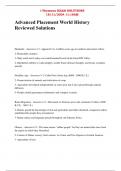©Themoon EXAM SOLUTIONS
18/11/2024 11:18AM
Advanced Placement World History
Reviewed Solutions
Hominids - Answers✓✓1- Appeared 3 to 4 million years ago in southern and eastern Africa
2- Humanlike creatures
3- Mary and Louis Leakey excavated hominid fossils in the Great Rift Valley
4- Bipedalism (ability to walk upright), sizable brain (abstract thought), and larynx (complex
speech)
Neolithic Age - Answers✓✓1- Called New Stone Age (8000 - 5000 B.C.E.)
2- Domestication of animals and cultivation of crops
3- Agriculture developed independently in some areas but it also spread through cultural
diffusion
4- People settled (permanent settlements) and complex societies
Bantu Migration - Answers✓✓1- Movement of Africans across the continent of Africa (3000
B.C.E. - 500 C.E.)
2- Bantus spread the knowledge of iron and agriculture and either absorbed, conquered, and/or
annihilated the people they encountered
3- Bantu culture and language spread throughout sub-Saharan Africa
Olmecs - Answers✓✓1- The name means "rubber people" for they are named after trees from
the region in which they flourished
2- Centers of Olmec society: San Lorenzo, La Venta, and Tres Zapotes in Central America
3- Agriculture (Corn)
, ©Themoon EXAM SOLUTIONS
16/11/2024 17:33PM
4- Famous sculpture: gigantic human heads
Mayan Civilization - Answers✓✓1- Located in present-day southern Mexico, Guatemala,
Belize, Honduras, and El Salvador
2- Classical Maya ruled from ca. 300-900 C.E.
2- Agriculture: cotton, maize, cacao
3- Achievements: writing, accurate calendar
4- Built eighty large ceremonial centers, which included pyramids; large centers included
Palenque, Chichén-Itzá, and Tikal
5- Approximately 800 C.E. people abandoned cities
Teotihuacán - Answers✓✓1- City built in central Mexico
2- At height (approximately 400-600 C.E.) 200,000 people
3- Two most important monuments: colossal pyramids of the sun and the moon
4- Artwork suggests a theocratic government - priests were crucial to the survival of society -
kept calendar and scheduled planting and harvesting
Chavín - Answers✓✓1- At roughly the same time that the Olmec civilization was flourishing in
Mesoamerica, this civilization dominated a heavily populated region that included both the
Peruvian coastal plain and foothills of the Andes
2- The coast of Peru has little rainfall, and in some places is quite narrow, but the abundance of
fish and other sea life provided a dependable supply of food
3- The capital, Chavín de Huántar, was located in a high mountain valley at an intersection of
trade routes
4- Part of its influence appears to be based on its religion
Deng Xiaoping - Answers✓✓1- In 1976, he replaced Mao Zedong as leader of communist
China
2- He introduced economic reforms but little extension of individual political rights
, ©Themoon EXAM SOLUTIONS
18/11/2024 11:18AM
3- Four Modernizations: an attempt to promote trade and contact with the West
4- He reformed land distribution and allowed some private ownership
5- However, he ordered troops to crush the pro-democracy movement in Tiananmen Square
OPEC - Answers✓✓1- An organization of producers of oil established in 1960
2- Member nations include Abu Dhabi, Algeria, Ecuador, Gabon, Indonesia, Iran, Iraq, Libya,
Kuwait, Nigeria, Qatar, Saudi Arabia, and Venezuela
3- Goal: to control the supply and price of oil through cooperation among member nations
Mikhail Gorbachev - Answers✓✓1- Controlled the Soviet Union from 1985 to 1991
2- Introduced reforms like glasnost (openness) and perestroika (economic restructuring)
3- Allowed people to speak out against the Soviet state
4- Backed free-market reforms
5- Agreed not to enforce the Brezhnev Doctrine, instead allowed Eastern bloc nations to
determine their own political futures
Nongovernmental Organizations (NGOS) - Answers✓✓1- A group that has no connection to a
government; not funded by one government
2- An example is The International Red Cross: an international humanitarian agency, created to
help prisoners of war, the wounded, and civilians in wartime; later extended to peacetime
3- Greenpeace: An environmental organization; its goal is to preserve earth's natural resources
and wildlife
Zheng He - Answers✓✓1- A eunuch admiral who led seven exploratory voyages for Ming
China from 1405 to 1433
2- Traveled to Southeast Asia, Ceylon, India, the Persian Gulf, Arabia, and the East African
coast, where he established tributary relationships
3- Ming emperors abruptly pulled funds from Zheng He's expeditions because they thought the
funds would be better spent on agriculture and protection from northern nomads
, ©Themoon EXAM SOLUTIONS
16/11/2024 17:33PM
Confucius - Answers✓✓1- Lived during the Age of Warring States period in China
2- Sought to restore order
3- Believed in Five Relationships: Emperor-Subject, Father-Son, Husband-Wife, Elder Brother-
Younger Brother, Friend-Friend
4- The superior in the relationship had to set a moral example while the inferior had to obey
More on Confucianism - Answers✓✓1- The best way to promote good government is to hire
people who were well educated and conscientious
2- Focused on the formation of Junzi ("superior individuals")
3- Ren (courteousness, respectfulness, and loyalty)
4- Li (a sense of propriety, appropriate behavior)
5- Xiao (filial piety, respect by children for parents and other elders)
Daoism - Answers✓✓1- An alternative solution to end the Warring States period in China -
contrary to Confucian beliefs
2- Central concept - "The Way of Nature"
3- Humans should stop trying to achieve personal goals and live very simply in order to achieve
harmony with nature
4- Wuwei - important moral trait whereby people remove themselves from worldy affairs
5- Yin Yang - how seeming contrary forces are interconnected
Legalism - Answers✓✓1- One of the major philosophies that emerged from the Hundred
Schools of Thought during the Warring States period
2- The goal - expanding and strengthening the state at all costs
3- Strict laws with harsh punishments lessen the number and serverity of crimes
4- Significant Legalist philosopher - Han Feizi
5- Used by the Qin dynasty, led by Shi Huangdi, to end the Warring States period




